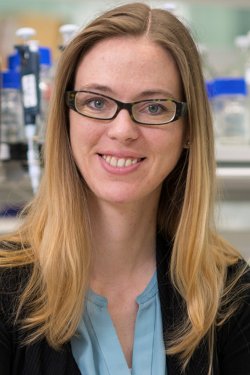Madeline Lancaster
2022 United Kingdom Award Winner — Faculty

Current Position:
MRC Investigator
Institution:
MRC Laboratory of Molecular Biology (LMB)
Discipline:
Neuroscience

Current Position:
MRC Investigator
Institution:
MRC Laboratory of Molecular Biology (LMB)
Discipline:
Neuroscience
Recognized for: Pioneering development of the first method for generating brain organoids from human induced pluripotent stem (iPS) cells, a technology that is ushering in a new era of neuroscience research. Her work using organoids to investigate the blood-brain barrier, primate brain evolution, and fetal brain development will help reveal fundamental knowledge about how human brains evolved and how they are affected by disease.
Areas of Research Interest and Expertise:
Developmental Neuroscience, Genetics & Genomics, Evolution, Stem Cell Biology
Previous Positions:
BA, Biochemistry, Occidental College, USA
PhD, Biomedical Sciences, University of California, San Diego, USA
Postdoctoral Fellow, Institute of Molecular Biotechnology, Austria
Research Summary:
The human brain has evolved several features that may account for many of the cognitive abilities that make humans a unique species in the animal kingdom. These specific and singular features also make human brain development difficult to study using animal models. To tackle this problem, Madeline Lancaster, PhD, has developed in vitro cerebral organoid models—brain tissues grown in the lab that are created from reprogrammed human stem cells, or human induced pluripotent stem (iPS) cells.
The brain organoids that Lancaster has pioneered model human embryonic and fetal brain development and generate the correct tissue architecture, cell types, and molecular environment. In addition, Lancaster has developed an organoid model of the choroid plexus, an organ within the brain responsible for secreting cerebrospinal fluid (CSF), an essential liquid in the brain. The choroid plexus is also involved in the formation of the blood-CSF barrier, a biological filter that prevents molecules from entering the brain via blood circulation. Since most drugs targeting the brain must cross this barrier, Lancaster’s organoid model of the choroid plexus allows researchers to study this process during development and as the barrier matures, a step that is essential for designing improved treatments for brain diseases.
Lancaster’s landmark work on brain organoids has far-reaching implications, from basic and clinical investigations into human development and disease to a deeper and more nuanced understanding of how human brains have evolved over time.
"I am incredibly honoured to receive this recognition. These past few years have been challenging for myself and my team, so to have all that hard work recognised is a real boost and encourages us to continue to develop these methods and ask really big questions"
Key Publications:
Other Honors:
| 2021 | Dr. Susan Lim Award for Outstanding Young Investigator, International Society for Stem Cell Research |
| 2021 | Vallee Scholars Award |
| 2019 | Young Investigator Award, EMBO-YIP |
| 2015 | 3Rs Prize, NC3Rs, UK |
| 2014 | Eppendorf Young European Investigator award |
In the Media:
Cambridge Independent – Mini-brains used at MRC Laboratory of Molecular Biology to study development and disease
Mind Matters – Do larger brains make us human? Is that all?
Cosmos Magazine - Why do humans have bigger brains than apes?
The Times – Cambridge lab grows small brains to answer the big questions
New Scientist – Mini-brains show why human brains grow larger than those of other apes
Nature – Can lab-grown brains become conscious?
The Times – The scientist who grows tiny brains in her laboratory
Financial Times –A mini revolution in brain science
The Economist – An embryonic idea, growing model brains
The Guardian -Scientists grow 'mini-brain on the move' that can contract muscle